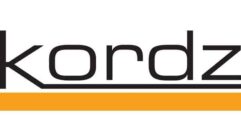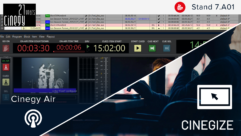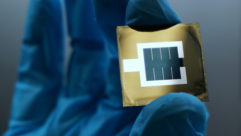
The Promise To Change Pro AV
Which technologies are set to influence the pro AV industry over the next few years? Here are nine good bets.
Hewlett-Packard’s Memory Spots are computer chips roughly the size of a grain of rice. Initial protoypes can store up to 500 KB, making them practical for digital signage applications, where passers-by can download information about the advertised product to their cell phone.
The only constant in pro AV’s product development pipeline these days is change. Although that’s somewhat cliché, it’s also an accurate description of how this industry is evolving along with cutting-edge technologies. We’ve picked nine technologies that have either already begun to affect pro AV or are likely to do so over the next few years. Some come from other industries, such as free space optics from telecom. Others don’t even have an industry to call home because they’re still in the early stages of research and development (R&D). Despite their differences, they all hold one thing in common — the promise to make quantum improvements in the way AV signals are transmitted, delivered, stored, or converted.
NFC and RFID
Radio frequency identification (RFID) tags are thin, thumbnail-size integrated circuits that retailers wirelessly scan to get information about the products that they’re attached to. Although they’re currently used for tasks such as inventory, RFID also creates opportunities for pro AV.
One example is ADvantage RFID, an interactive digital signage system developed by BTV+, based in Mississauga, Ontario, Canada. The ADvantage displays have an embedded RFID scanner that triggers ads when a tagged product is picked up. (The scanner can also be added to existing displays for about $900 each.)
The business case for AV systems such as ADvantage hinges largely on how retailers use RFID. Although major chains such as Wal-Mart increasingly require suppliers to use RFID, the tags are found mainly on pallets and cartons of products rather than the products themselves. (Exceptions include high-value items, such as CDs.) As the cost of tags drops from a current average of 10 to 20 cents apiece, suppliers and retailers can justify tagging a wider range of individual products, making RFID displays more practical.
RFID has a range of several feet, depending on the technology standard used. A similar technology is near-field communications (NFC), which has a range of about 4 cm. NFC can be paired with other wireless technologies, such as Bluetooth and 802.11 WiFi, to establish a secure link that is then transferred to the other technology only after both parties have been authenticated.
Although NFC is a newer technology, it’s already catching on with wireless carriers such as Cingular Wireless and cell phone manufacturers such as Nokia. By 2010, more than half of all cell phones — roughly 500 million —will have NFC built in, according to ABI Research, an independent analyst firm based in Oyster Bay, NY.
The initial NFC standards were released in August 2006, but the technology is already in trials in Germany and at Atlanta’s Philip’s Arena, where it’s used for cashless payments. Like RFID, NFC has applications outside of pro AV, such as facilitating cashless payments. That usage is worth watching because the more that other industries use NFC and RFID, the lower the cost of hardware and software for pro AV.
That adoption also creates an installed base of cell phones and other devices that can be leveraged for AV applications. One example is “smart objects,” such as digital signage that uses NFC transceivers to send the URL for a movie trailer. If users like it, they can use NFC to buy an electronic ticket.
For more information about NFC and RFID, visit:
- The NFC Forum’s website at www.nfc-forum.org.
- For news and information about RFID, visit www.rfidgazette.org,www.rfidjournal.com, and www.rfidupdate.com.
Gigabit Ethernet
Ethernet turned 30 this year, but the networking technology is as viable as ever. In fact, besides remaining the local-area network (LAN) technology of choice in the enterprise market, the technology is also becoming the preferred wide-area network (WAN) standard for telecom service providers such as Verizon Communications.
For example, Infonetics Research says that worldwide revenue from Ethernet services more than doubled to $5.9 billion between 2004 and 2005, and it expects the market to top $22.5 billion by 2009. That growth is due partly to enterprise interest in Ethernet, which is up to 50 percent less expensive than maintaining separate networks for voice and data communications.
Service provider adoption of Ethernet means that the technology is becoming an option for long-haul, bandwidth-intensive AV applications such as multi-office videoconferencing. Ethernet’s growing bandwidth also makes it a good fit for HD video. In the enterprise space, a common version is 1 G/bits — known as Gigabit Ethernet or simply “Gig-E” — but service providers often use 10 G/bits and higher technology for their network backbones.
Despite that bandwidth, not all Ethernet services are suited for delay-sensitive AV applications. One issue is quality-of-service (QoS) mechanisms that service providers and AV equipment manufacturers can add in to ensure a good user experience. “We see a proliferation of QoS bandwidth services as being a key trend to high-quality telepresence deployments,” says Rick Ono, chief operating officer at Telanetix, a San Diego-based company that specializes in videoconferencing. “Most networks have been deployed to support data and voice traffic. Flawless video transmission requires a network that has addressed issues such as latency and jitter.”
Although Ethernet has enough speed to support HD videoconferencing, companies such as Telanetix argue that a good user experience depends less on the sheer amount of bandwidth available and more on how that bandwidth is managed. “We believe that a quality videoconference goes beyond the number of pixels on the screen,” Ono says. “For example, latency and the elimination of blocking and trails are more important considerations. These issues can be addressed with a well-developed, integrated system that addresses not just the codec, but bandwidth management as well.”
For an overview of Ethernet technology and marketplace, visit the Metro Ethernet Forum’s website at www.metroethernetforum.org.
Memory spots
Walk past an ad in a major city, and chances are you can stop, whip out your cell phone, and download a multimedia clip. One example: At New York City’s Grand Central Terminal, CBS is offering free clips of its prime-time shows.
Hewlett-Packard wants to take that scenario to the next level with Memory Spots, which are computer chips roughly the size of a grain of rice that can store up to 500 KB in the initial prototypes — enough for a 100-page document. Future versions are likely to have enough capacity to store video clips, but the current prototypes have enough storage to make them practical for digital signage applications, where passers-by download information about the product being advertised. For consumers, that’s more convenient than asking them to scribble down a web address to look up later or pecking it into their Internet-ready cell phone.
“I don’t have to go out to a website and wait for something to download,” says Howard Taub, vice president and associate director of HP Labs, based in Palo Alto, CA. “It all happens in a few seconds. It’s instant gratification.”
Other systems, such as CBS’ signage, use Bluetooth, a short-range wireless technology that musters about 1 Mb/s under ideal conditions. “The prototype Memory Spot chips we’re working with right now run at 10 Mb/s, and 40 Mb/s wouldn’t be a big problem,” Taub says.
Unlike Bluetooth and RFID, Memory Spots are designed to be read from a distance of about 1 mm. That’s largely because the spots don’t have a power source. Instead, the information transfer is powered entirely by the device that’s reading them. For AV applications, installing the spots should be as simple as peel and stick rather than providing them with a power source. A side benefit of this short read range is security because an eavesdropper would have to be so close that it could arouse suspicion. “For a lot of applications, people worry about things that you can read from 10 feet away,” Taub says.
Memory Spots are still a few years from commercial availability, but Taub expects to be doing a major test with a potential licensee by late 2007. HP also recently joined the NFC Forum in hopes of having Memory Spot’s technology used in future NFC standards.
For more information about Memory Spots, visit HP Labs’ website at www.hpl.hp.com.
Free space optics
Light amplification by simulated emission of radiation (laser) technology has been in commercial use for decades. In AV, it’s used mainly for pointers, but companies such as Mitsubishi Electric are developing displays that use lasers as a light source.
Pioneered by Alexander Graham Bell more than a century ago, free space optics (FS0) technology uses lasers to transmit data at speeds ranging from T1 to 1.5 Gb/s — fast enough for apps such as HD video. Unlike wireless, FSO is immune to interference, so the technology gives AV pros more design and installation flexibility.
Lasers also can be used for broadband communications. One example is fSONA Systems, a McLean, VA-based vendor that specializes in free space optics (FSO), the telecom industry term for laser communications. fSONA’s hardware supports speeds ranging from T1 to 1.5 Gb/s, so it’s fast enough for applications such as HD video. Future versions could go as high as 160 Gb/s.
Besides speed, one benefit for pro AV applications is that FSO hardware can be deployed faster than pulling cable or installing and tweaking a wireless system. For example, an installation linking several buildings on a campus consists of setting up tripod-mounted transceivers by windows that allow a clear view of the next transceiver, which can be up to 7 km away — a process that fSONA says takes a few hours. The metallic window coatings used in many offices and commercial buildings cut the signal strength, but in most cases, it’s not an issue. “Unlike radio frequency (RF), there’s no degradation of bandwidth associated with attenuated receive power,” says Sunny Taylor, CEO and president of fSONA.
FSO doesn’t require licensed spectrum, and unlike wireless technologies such as 802.11 WiFi, it’s immune to eavesdropping. “With no RF being emitted, there’s no concern for licensing or interference with existing wireless systems,” Taylor says. Those features make FSO akin to fiber in the sense that interference is a non-issue, so AV integrators have more design and installation flexibility, which helps save money.
fSONA says that some of its customers use FSO for applications such as real-time surveillance video and for digital broadcast video for sporting events. FSO systems with two transceivers range from $15,000 to $39,000, depending on bandwidth.
For more information about FSO and other types of lasers used in AV, visit:
- fSONA’s website at www.fsona.com.
- For an overview of how FSO technology works, as well as information about other FSO vendors, visit www.freespaceoptic.com.
Carbon nanotubes
Carbon nanotubes are microscopic cylinders roughly 50,000 times thinner than a human hair. Discovered in 1991, they can conduct electricity, making them a viable option for a wide variety of AV products.
One example is the ribbon in ribbon mics. The mic design is popular because the pick-up is linear, with low distortion, but the ribbon is difficult to manufacture, which drives up the mic’s price. Ashland, MA-based Soundwave Research Laboratories has developed ribbon mics that replace the ultra-thin strip of aluminum foil with a ribbon made of carbon nanotubes, which are tougher and thus easier to manufacture into mic ribbons.
Besides collecting sound, carbon nanotubes can also emit light. The catch is that the material wasn’t efficient at converting electrons into photons. But IBM researchers have developed a different conversion process that’s 1,000 times more efficient. That breakthrough moves the material closer to being a possible solution for AV applications, such as grouping them together to form powerful backlights for displays or even displays themselves.
Roughly 50,000 times thinner than a human hair, carbon nanotubes conduct electricity, making them a viable option for a variety of AV applications, including the ribbon in ribbon mics. IBM researchers recently developed a way to make carbon nanotubes emit light efficiently, so the technology one day could be used as backlights for displays or even displays themselves.
Past attempts shot positive- and negative-charged particles at each other to cause them to recombine and produce a photon — a process similar to light-emitting diodes (LEDs). “We found a different way to make photons out of electrons,” says Jia Chen, a research staff member at the IBM T. J. Watson Research Center in Yorktown Heights, NY. “We were able to ‘coerce’ the electrons to convert the energy to light instead of heat.”
As a result, every electron injected into the carbon nanotube now contributes to producing light rather than wasted energy. IBM’s technique includes using substrates with different dielectric constants underneath the carbon nanotubes. “The new method generates about 100,000 times more photons per unit area per unit time than large-area LEDs, and from an area that’s a trillionth of the emitting area of a regular 60 W tungsten filament light bulb,” Chen says.
Chen and her colleagues still have about five to 10 years’ worth of R&D work before their techniques are ready for commercialization. Issues include figuring out ways to ensure uniformity in terms of each nanotube’s color and lifespan. On the plus side, their techniques can leverage existing semiconductor manufacturing equipment and processes. That should help reduce their cost, thereby improving the chances AV vendors can make a business case for using the technology.
For more information about nanotubes in AV, visit:
- The IBM T. J. Watson Research Center’s Nanoscale science and technology group website at www.research.ibm.com/nanoscience.
Next-gen wireless
Wireless should be a slam-dunk in pro AV because it’s faster and often cheaper than installing cable. But several factors — particularly ease of use and speed —have kept the technology a niche play.
That could be about to change, thanks to three new technologies. The first is Bluetooth, which pro AV currently uses for low-bandwidth tasks such as enabling digital whiteboards. The Bluetooth Special Interest Group (SIG) is developing a next-gen version that could support up to 480 Mb/s for connections a few feet apart. That’s enough bandwidth for an HD video stream, plus any control channels for background communications between devices.
The SIG expects commercial next-gen Bluetooth products to debut sometime in 2007. If that schedule holds, it will be going up against another new technology: 802.11n, which is the successor to the 802.11 a, b, and g WiFi technology used in some pro AV products, such as projectors. (Although 802.11n products are commercially available today, they’re based on a preliminary version of the standard.) In fact, 802.11n is expected to deliver peak data rates of about 100 Mb/s, although some chipset vendors envision speeds beyond 600 Mb/s.
One difference between 802.11n and next-gen Bluetooth is range: about 300-plus feet for 802.11n and one-tenth that for Bluetooth. That makes 802.11n a better fit for lengthy links, such as a laptop communicating with a projector at the other end of an auditorium.
Another difference is ease of use. All versions of WiFi require additional layers of vendor software to make it easy, for example, for a person to walk into a conference room, pull out a laptop, and use WiFi to connect to a projector. Vendors say that the lack of a fast, easy connection is the main reason why WiFi is rarely used in pro AV.
By comparison, Bluetooth originally was designed as a way to provide plug-and-play wireless connections between devices, including those that don’t have a screen to help facilitate that task. Bluetooth uses a process called “discovery” to find other nearby devices and establish a connection with minimal user intervention. That ability is included in next-gen Bluetooth and could help it bring wireless to pro AV applications that have avoided wireless due to connection hassles.
That’s not to say that current-gen WiFi doesn’t have a place in pro AV. One company working to carve out a bigger niche is Avocent, based in Huntsville, AL. Avocent developed compression technology to shoehorn more bandwidth through an 802.11 connection. In some cases, those systems deliver performance on par with what 802.11n is expected to offer. So for applications where a fast, wire-free link is more important than an easy connection, solutions such as Avocent’s fill a need.
Another wireless technology to watch is ultrawideband (UWB), which uses Morse code-like pulses of energy to transmit data at speeds of up to 480 Mb/s or more. The pulse approach makes the UWB signal more resistant to physical obstructions, such as walls, so they’re less of an issue when designing or installing a UWB-based AV system. Both UWB and Bluetooth have a range of about 33 feet, although they can be souped up to travel greater distances. The similarities don’t end there: Earlier this year, the Bluetooth SIG began incorporating UWB techniques for the next-gen version of its technology.
Research firms such as Scottsdale, AZ-based In-Stat expect manufacturers to start ramping up UWB chipset production by the end of this year, with annual shipments of about 289 million by 2010. In-Stat says PCs will be the initial market, with 125 million UWB-enabled desktops and laptops by 2010. That adoption is noteworthy because makers of pro AV products such as projectors typically base their interface choices on the wired and wireless technologies used by the PC industry.
UWB can be found in a few commercial pro AV products today. One example is the Wireless HDMI Extender from Woodland Hills, CA-based Gefen. The company says the product handles HD streams and has a range of about 60 feet.
For more information about wireless in AV, visit:
- Avocent’s website at www.avocent.com.
- The Bluetooth SIG’s website at www.bluetooth.com.
- The IEEE 802.11n Task Group website at http://grouper.ieee.org/groups/802/11/Reports/tgn_update.htm.
- The UWB Forum’s website at www.uwbforum.org.
- Gefen’s Wireless HDMI Extender announcement at www.gefen.com/kvm/news/CEDIA2006-6.jsp.
Tim Kridel is a freelance writer and analyst who covers telecom and technology. He’s based in Kansas City and can be reached at [email protected].
For more information about the technologies discussed in this article as well as other related technologies, check out:
- What’s Next: Sign Of The Times – RFID tags are the successor to UPC labels — and a potential market for digital signage, December 2005 Pro AV
- What’s Next: A Better Light – After nearly a half-century of development, lasers are set to move inside TVs, digital signage, and cinema projectors, April 2006 Pro AV
- What’s Next: Sound Potential – Next-generation ribbon mics will debut inside blood vessels before they hit pro AV, January 2006 Pro AV
- What’s Next: Speed Isn’t Everything – Next-gen WiFi will be faster and more reliable, but wireless is likely to remain a bench-warmer rather than a starter, October 2005 Pro AV
- What’s Next: Blue Streak – A new version of Bluetooth has enough speed for pro AV, but throughput alone isn’t the only benefit, July 2006 Pro AV










